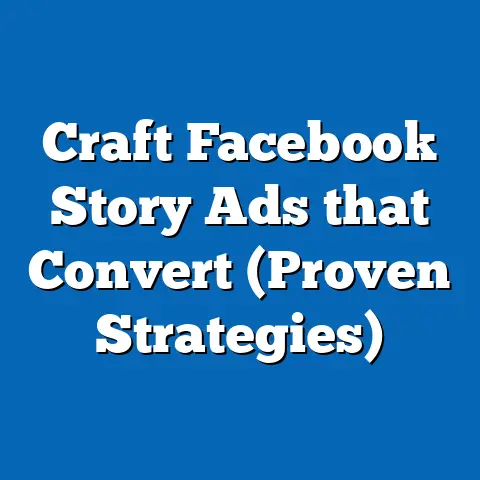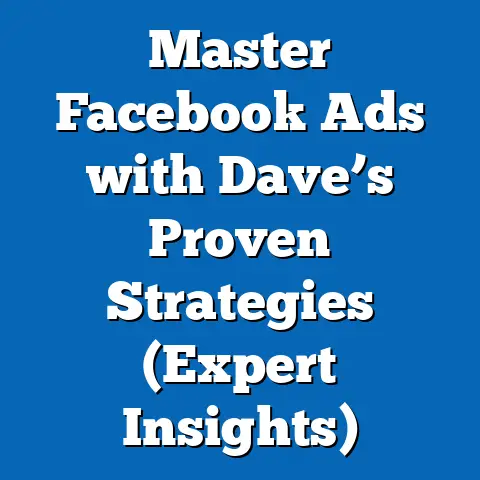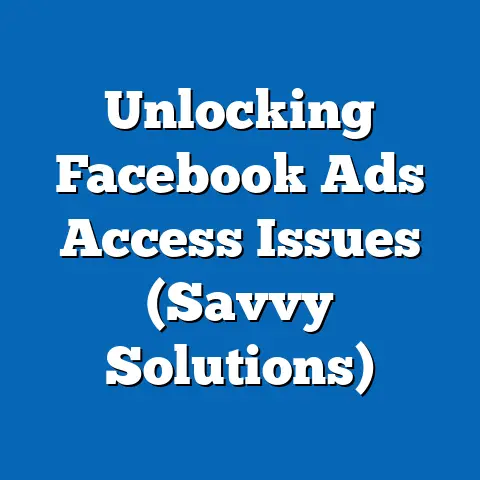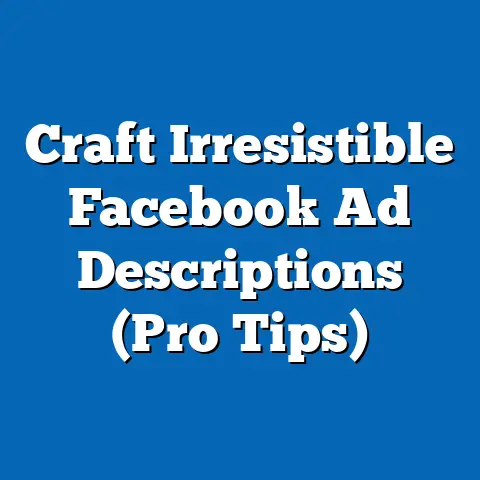Maximize Facebook Ad Preview Effectiveness (Pro Tips)
Allergies, though seemingly unrelated to digital marketing at first glance, provide a compelling metaphor for understanding the need for precision and customization in areas like Facebook ad previews. Allergies are adverse immune responses to specific substances—known as allergens—ranging from pollen and dust mites to foods like peanuts or shellfish. They affect millions globally, with the World Allergy Organization estimating that 30-40% of the world’s population suffers from some form of allergic disease.
Historically, allergies were less understood and often misdiagnosed until the 20th century when immunology emerged as a field of study. The term “allergy” was coined in 1906 by Clemens von Pirquet, an Austrian pediatrician, to describe altered reactions to external stimuli. Over time, societal awareness grew, particularly as industrialization and urbanization exposed populations to new allergens, from processed foods to pollution.
The societal implications of allergies are vast, influencing healthcare systems, workplace productivity, and even personal lifestyles. Allergies cost billions annually in medical expenses and lost workdays, with the American Academy of Allergy, Asthma & Immunology reporting that allergies are the sixth leading cause of chronic illness in the U.S. Moreover, they shape social behaviors—think of peanut-free schools or gluten-free menus—mirroring how tailored solutions are needed for diverse needs.
This concept of tailoring solutions to specific triggers or needs parallels the essence of effective Facebook ad previews. Just as allergies require precise identification of triggers and customized responses, crafting impactful Facebook ads demands a deep understanding of audience nuances and targeted testing through previews. This article will explore how to maximize the effectiveness of Facebook ad previews with pro tips, drawing on the broader theme of personalization and adaptation.
Section 1: Understanding Facebook Ad Previews – The Basics
Facebook ad previews are tools within the Facebook Ads Manager that allow marketers to visualize how their advertisements will appear across different placements, such as desktop news feeds, mobile feeds, Instagram stories, or audience network banners. These previews are critical for ensuring that creative elements—images, text, and calls-to-action—render correctly and resonate with the intended audience before the campaign goes live.
The importance of previews cannot be overstated in a digital landscape where first impressions are often the only impressions. According to a 2022 report by Hootsuite, users spend an average of just 1.7 seconds on a piece of content in their Facebook feed, underscoring the need for ads to be visually compelling and contextually relevant from the outset.
Previews also serve as a diagnostic tool, helping advertisers identify potential issues like text truncation, image cropping, or mismatched messaging across devices. Much like diagnosing an allergic reaction requires understanding specific symptoms, effective ad previews require marketers to anticipate how different audience segments and platforms will “react” to their content.
Section 2: Historical Context of Digital Advertising and the Evolution of Previews
Digital advertising has evolved dramatically since the first online banner ad appeared in 1994 on HotWired.com. Early digital ads were static and lacked the interactivity or targeting capabilities we see today. By the early 2000s, platforms like Google AdWords introduced contextual targeting, while social media platforms like Facebook, launched in 2004, revolutionized advertising with user data-driven personalization.
Facebook’s ad platform, introduced in 2007 with “Facebook Flyers,” initially offered rudimentary tools for advertisers. The concept of ad previews emerged later as the platform recognized the diversity of user experiences across devices and demographics. By 2012, with the introduction of Ads Manager, previews became a staple feature, reflecting the growing complexity of ad placements and the need for real-time visualization.
This evolution mirrors societal shifts in allergy management, where increased knowledge and technology—like allergy testing kits—enabled more precise interventions. Similarly, ad previews have become indispensable in a world where a one-size-fits-all approach to advertising no longer suffices, given the diversity of user behaviors and platform algorithms.
Section 3: Key Characteristics of Effective Facebook Ad Previews
To maximize the effectiveness of Facebook ad previews, several key characteristics must be prioritized. First, clarity in rendering ensures that all creative elements display as intended across placements. For instance, a headline that looks perfect on desktop might be cut off on mobile if not tested properly.
Second, audience relevance is critical. Previews allow marketers to see how ads appear to different demographics or custom audiences, ensuring that messaging aligns with cultural or regional nuances. A 2021 study by Statista found that 74% of consumers feel frustrated when content is irrelevant to them, highlighting the stakes of mismatched ads.
Third, adaptability across formats—such as Stories, carousels, or videos—ensures a seamless user experience. Just as allergy treatments must adapt to varying severities or triggers, ad previews must account for the dynamic nature of digital consumption, where users might engage via a quick swipe or a prolonged scroll.
Section 4: Pro Tips for Maximizing Facebook Ad Preview Effectiveness
Below are actionable, research-backed strategies to optimize the use of Facebook ad previews, ensuring campaigns are polished and impactful before launch.
4.1 Leverage All Placement Previews
Facebook offers previews for over a dozen placements, from Marketplace to Messenger. Testing each placement is non-negotiable, as a 2023 report by Social Media Today indicates that 68% of ad impressions occur on mobile devices, often in unique formats like Stories or in-stream videos. Previewing across placements helps identify formatting issues—such as distorted images in Instagram Stories—and allows for adjustments to maintain visual integrity.
Marketers should also use the “Preview in All Placements” feature to compare how an ad’s tone or call-to-action translates across contexts. For example, a playful tone might work in a Stories ad but seem out of place in a professional Audience Network placement.
4.2 Test Multiple Creative Variations
Just as allergists test for multiple triggers to pinpoint a reaction, advertisers should preview multiple ad variations—different headlines, visuals, or CTAs—to gauge potential performance. Facebook’s Dynamic Creative tool can automate this process, but manually previewing top combinations ensures nothing slips through the cracks.
A study by Nielsen in 2022 found that campaigns with varied creative assets saw a 15% higher click-through rate (CTR) compared to single-asset campaigns. Previews help visualize which elements stand out or fall flat, informing data-driven refinements.
4.3 Simulate Audience Perspectives
Facebook ad previews allow marketers to view ads as specific audience segments would see them, based on demographics or interests. This feature is akin to understanding how different individuals react to allergens—personalization is key. For instance, an ad for eco-friendly products might use different imagery for urban millennials versus rural Gen X audiences.
Marketers should cross-check previews with audience insights from Facebook Analytics to ensure messaging aligns with user expectations. Missteps here can lead to disengagement, much like an ill-suited allergy treatment can worsen symptoms.
4.4 Optimize for Mobile-First Experiences
Given that mobile accounts for the majority of Facebook usage, previews must prioritize mobile rendering. Text should be concise—under 20% of an image, per Facebook’s guidelines—to avoid rejection or reduced reach. Images should also be high-resolution to prevent pixelation on smaller screens.
A 2023 survey by eMarketer revealed that 82% of users abandon ads that load slowly or display poorly on mobile. Previews help catch these issues early, ensuring a smooth user experience akin to providing immediate relief for an allergic reaction.
4.5 Use Previews for Compliance Checks
Facebook’s ad policies are stringent, covering everything from prohibited content (e.g., misleading claims) to formatting rules. Previews act as a pre-launch compliance audit, helping marketers spot policy violations before submission. For example, an ad with excessive text overlay might be flagged in preview, saving time and budget.
This mirrors how allergy management often involves preemptive measures—like reading food labels—to avoid adverse reactions. Proactive use of previews minimizes campaign disruptions and maximizes approval rates.
4.6 Collaborate with Teams via Preview Sharing
Facebook allows users to share ad previews with team members or clients via a unique link, fostering collaboration. This feature ensures that feedback on design or messaging is incorporated pre-launch, reducing costly revisions. A 2021 study by HubSpot found that campaigns with collaborative input had a 20% higher ROI on average.
Sharing previews also builds transparency, much like how allergy patients share medical histories with doctors for better care. It’s a step toward aligning all stakeholders on campaign goals and aesthetics.
4.7 Monitor Preview Insights Alongside Live Data
While previews offer a pre-launch snapshot, their insights should be revisited post-launch alongside live performance metrics. If a previewed ad underperforms, marketers can analyze whether the issue lies in creative execution (visible in preview) or external factors like audience fatigue. Tools like Facebook’s Ad Library can also provide competitive context for refining future previews.
This iterative approach is similar to ongoing allergy management, where treatments are adjusted based on changing symptoms or environments. Continuous learning from previews ensures long-term campaign success.
Section 5: Societal and Cultural Implications of Effective Ad Previews
Economically, optimized previews reduce ad spend waste, allowing businesses—especially small enterprises—to compete in a crowded digital space. A 2022 report by the U.S. Small Business Administration noted that 60% of small businesses rely on social media advertising, making tools like previews critical for budget efficiency.
Culturally, previews help avoid missteps that could offend or alienate audiences. An ad that appears tone-deaf in preview—say, using outdated slang or insensitive imagery—can be revised to reflect cultural sensitivities, fostering inclusivity. This parallels how allergy awareness has led to societal shifts like allergen labeling, prioritizing collective well-being.
Section 6: Workplace Implications and Team Dynamics
In the workplace, mastering Facebook ad previews enhances marketing team efficiency and accountability. Previews streamline approval processes, reducing back-and-forth between designers, copywriters, and managers. This is particularly relevant in remote or hybrid work environments, where shared preview links facilitate asynchronous collaboration.
Moreover, proficiency with preview tools signals adaptability—a key skill in a fast-evolving digital economy. Marketers who leverage previews effectively often position themselves as strategic assets, capable of balancing creativity with data-driven decision-making. A 2023 LinkedIn report highlighted that 78% of hiring managers value digital marketing skills, including ad optimization, in candidates.
However, over-reliance on previews can stifle experimentation if teams become risk-averse, sticking only to “safe” creatives that preview well. Balancing preview insights with bold innovation is essential, much like how allergy patients balance caution with quality of life.
Section 7: Technological and Economic Factors Influencing Preview Effectiveness
Technologically, the rise of AI and machine learning has enhanced preview capabilities, with Facebook integrating predictive analytics to suggest optimal formats or placements during the preview stage. These advancements mirror how technology has improved allergy diagnostics, from skin prick tests to DNA-based allergen profiling.
Economically, the cost-effectiveness of previews is a game-changer for advertisers operating on tight budgets. By catching errors or inefficiencies pre-launch, previews minimize financial risk—a crucial factor as global digital ad spend is projected to reach $740 billion by 2025, per eMarketer. Yet, economic disparities mean not all businesses have equal access to training or tools needed to maximize previews, highlighting a digital divide.
Additionally, platform updates or algorithm changes can affect preview accuracy, requiring marketers to stay agile. This adaptability echoes the need for allergy patients to adjust to new environmental or dietary triggers over time.
Section 8: Nuances and Diversity in Ad Preview Strategies
It’s important to acknowledge that no single preview strategy works universally, just as no single allergy treatment suits all patients. Audience diversity—spanning age, geography, and behavior—demands tailored preview approaches. For example, a global campaign might require region-specific previews to account for language or cultural differences.
Similarly, industry nuances matter. A B2B tech ad might prioritize LinkedIn-style placements on Audience Network, while a fashion brand focuses on visually rich Instagram Stories. Previews must adapt to these contexts, avoiding a cookie-cutter approach.
Qualitative feedback from focus groups can complement quantitative preview data, offering deeper insights into emotional resonance or brand perception. This mixed-method approach ensures a holistic understanding, akin to combining medical tests with patient self-reports in allergy care.
Section 9: Forward-Looking Insights and Uncertainties
Looking ahead, the role of Facebook ad previews will likely expand with advancements in augmented reality (AR) and virtual reality (VR), enabling immersive ad experiences that require even more nuanced testing. Imagine previewing an AR ad where users virtually “try on” products—ensuring flawless rendering will be paramount.
However, uncertainties remain, including evolving privacy regulations like GDPR or CCPA, which could limit audience data used in previews. Marketers must prepare for a future where personalization balances with anonymity, much like allergy research navigates ethical concerns around genetic testing.
Additionally, as generational shifts bring Gen Alpha into the digital consumer space, preview strategies will need to adapt to their unique digital-native behaviors, which are still unfolding. The only certainty is change, requiring marketers to remain vigilant and adaptable.
Conclusion
Maximizing Facebook ad preview effectiveness is both an art and a science, requiring attention to detail, audience empathy, and technological savvy. From testing multiple placements to simulating audience perspectives, the pro tips outlined above offer a roadmap for crafting ads that resonate and convert. Much like managing allergies demands precision and personalization, so too does digital advertising in a crowded, fast-paced online world.
The societal, workplace, and cultural implications of effective previews underscore their broader significance, shaping how brands connect with diverse audiences and navigate economic constraints. While the future holds uncertainties— from privacy shifts to emerging technologies—the value of previews as a preemptive, diagnostic tool remains clear.
By embracing these strategies and maintaining a forward-looking mindset, marketers can turn the humble ad preview into a powerful lever for campaign success, ensuring that every impression counts in an increasingly competitive digital landscape.






